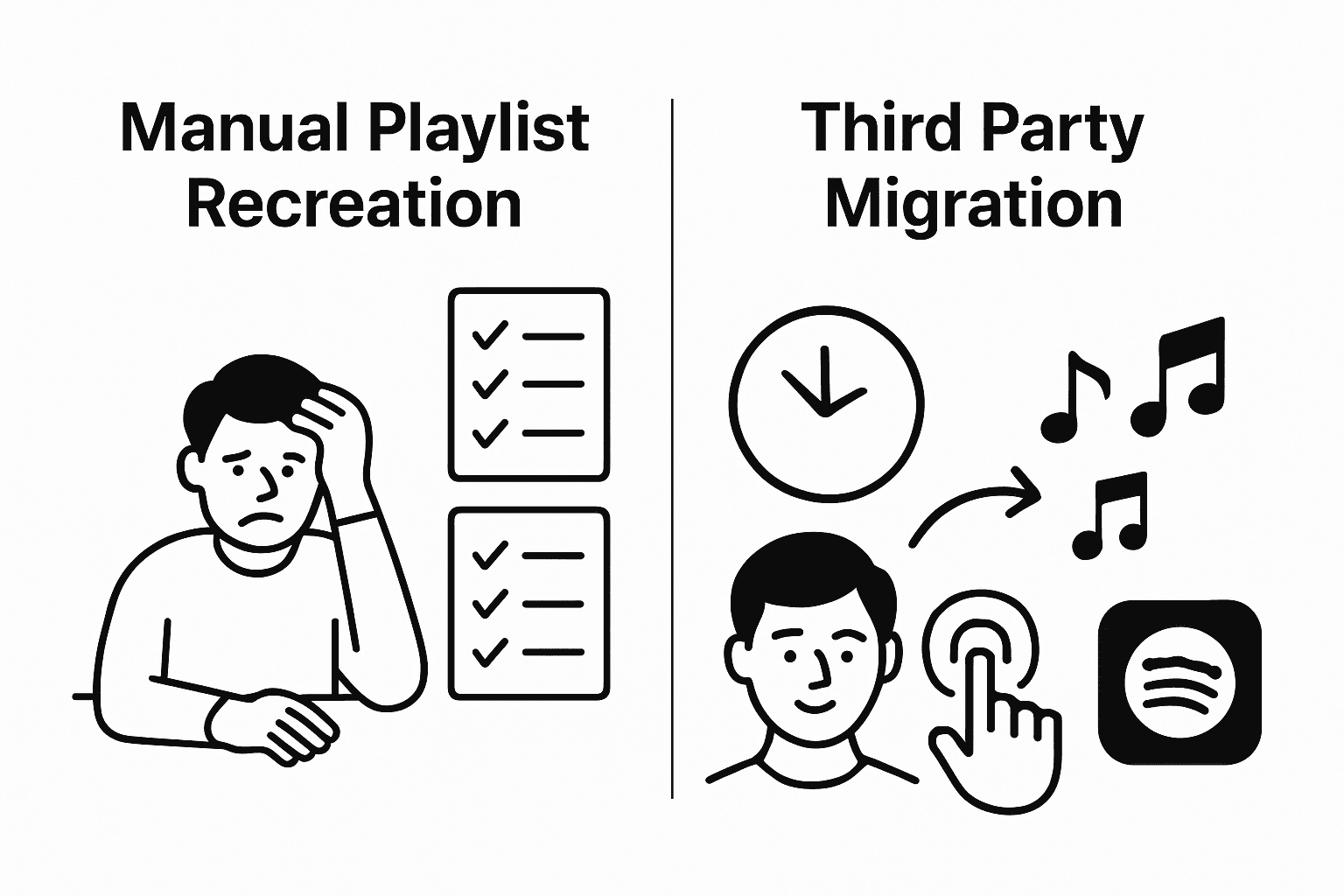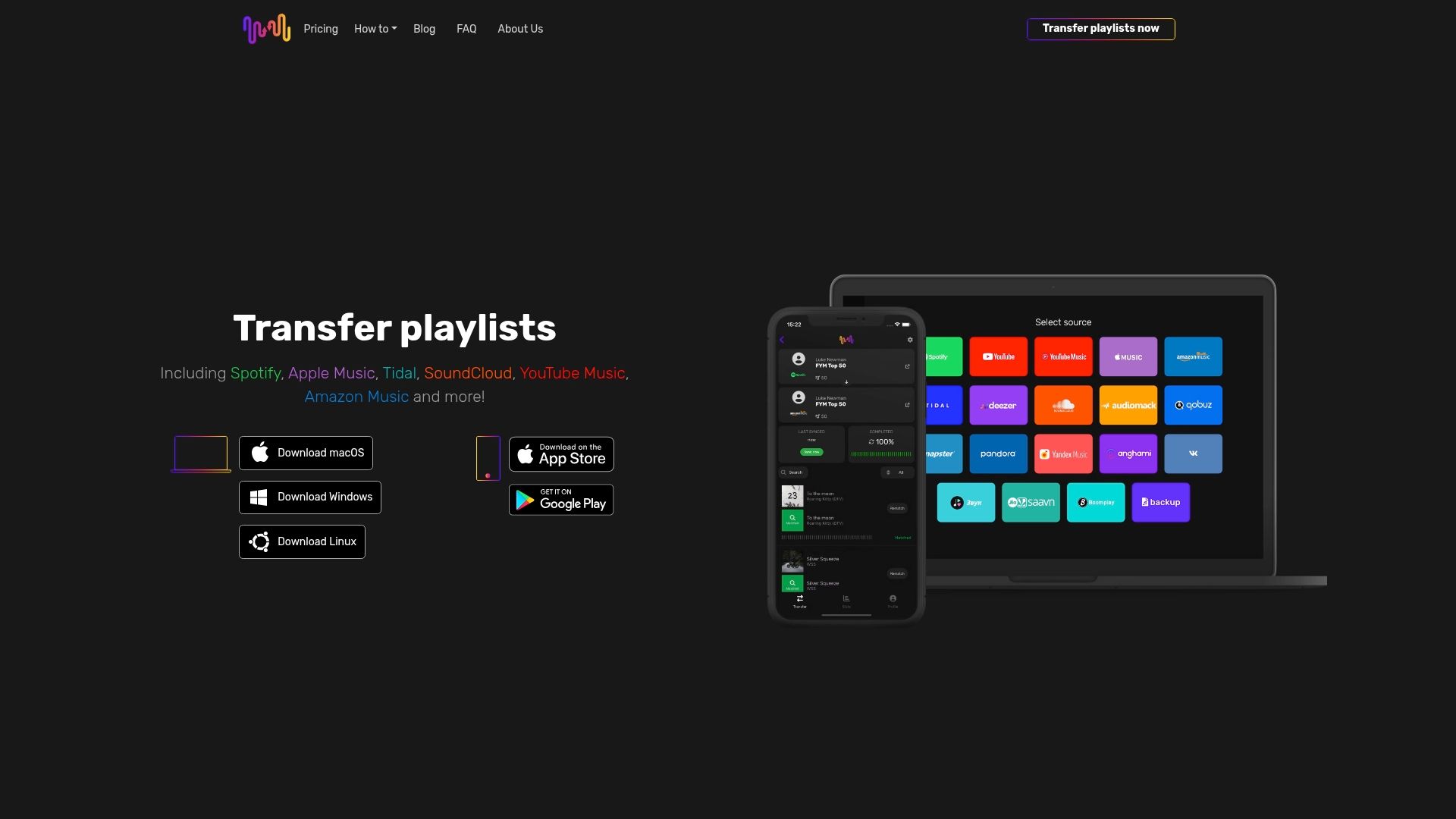Switching music streaming platforms can feel overwhelming, especially when your favorite playlists represent years of memories and careful curation. Yet over 65% of users hesitate to move to a new service simply because of the pain of rebuilding their music libraries from scratch. Most people think transfers are impossible without endless copy-pasting, but third party playlist migration tools flip the whole script and make music library freedom a reality.
Table of Contents
- Defining Third Party Playlist Migration
- Understanding The Core Concept
- Key Characteristics Of Third Party Migration Tools
- The Importance Of Playlist Migration In Music Streaming
- User Experience And Musical Continuity
- Digital Music Ecosystem Dynamics
- How Third Party Playlist Migration Works
- Technical Architecture Of Migration
- Algorithmic Song Matching Process
- Key Benefits Of Using Third Party Playlist Migration
- Preserving Musical Investments
- Strategic Music Consumption Flexibility
Quick Summary
| Takeaway | Explanation |
|---|---|
| Third party playlist migration simplifies music transfer. | It allows users to seamlessly transfer playlists between different streaming services without recreating them manually. |
| Preserve your curated playlists effortlessly. | Migration tools maintain playlist metadata and order, ensuring no loss of musical integrity during the transfer process. |
| Explore new streaming platforms without risk. | Users can switch services and retain their music collections, minimizing concerns about losing their curated libraries. |
| Enhanced user experience through advanced algorithms. | These tools utilize sophisticated technology for accurate song matching and secure data transfer, ensuring a smooth user experience. |
| Democratizes music consumption in digital landscape. | Playlist migration reduces platform lock-in, promoting user choice and fostering innovation among streaming services. |
Defining Third Party Playlist Migration
Third party playlist migration represents a sophisticated digital music management process that enables users to transfer their curated music collections seamlessly across different streaming platforms. This technological solution addresses the complex challenge of music library portability in an increasingly fragmented streaming ecosystem.
Understanding the Core Concept
At its fundamental level, third party playlist migration involves using specialized software or services to automatically transfer music playlists from one streaming platform to another. Unlike manual playlist recreation, these tools leverage advanced algorithms to match songs, preserve playlist order, and ensure the highest possible accuracy during the transfer process.

Learn more about playlist transfer options that can simplify your music library management.
Key Characteristics of Third Party Migration Tools
Effective third party playlist migration solutions typically share several critical characteristics:
- Comprehensive Platform Support: Ability to transfer playlists across multiple streaming services
- Accurate Song Matching: Advanced algorithms that identify equivalent tracks across different platforms
- Metadata Preservation: Maintaining playlist names, ordering, and additional track information
- User-Friendly Interface: Simple, intuitive processes that minimize technical complexity
According to EDUCAUSE's integration guidelines, successful third-party tools prioritize seamless user experience and robust technical performance. The goal is not just transferring music, but creating a frictionless transition that respects user preferences and musical collections.
Below is a table summarizing the key characteristics of effective third party playlist migration tools, making it easy to compare their core features at a glance.
| Characteristic | Description |
|---|---|
| Comprehensive Platform Support | Transfers playlists across multiple streaming services |
| Accurate Song Matching | Uses advanced algorithms to identify equivalent tracks on different platforms |
| Metadata Preservation | Maintains playlist names, track order, and additional metadata during the transfer |
| User-Friendly Interface | Offers an intuitive, simple experience to reduce technical barriers |
| Seamless User Experience | Minimizes friction, enabling effortless transitions and respecting musical collections |
| Robust Technical Performance | Ensures reliable operation with minimal errors and smooth data handling |
By understanding third party playlist migration, music enthusiasts can overcome platform limitations, explore new streaming services, and maintain their carefully curated musical libraries without compromise.
The Importance of Playlist Migration in Music Streaming
Playlist migration has emerged as a critical solution addressing the evolving challenges of digital music consumption. As streaming platforms proliferate and users become increasingly selective about their music experiences, the ability to seamlessly transfer musical collections represents a significant technological advancement.
User Experience and Musical Continuity
Music libraries are deeply personal collections that reflect individual tastes, memories, and emotional connections. When users switch streaming platforms, the potential loss of carefully curated playlists can be emotionally and practically disruptive. Explore playlist transfer strategies that help maintain your musical journey across different services.
Playlist migration ensures that users can:
- Preserve years of musical curation
- Minimize time spent manually recreating playlists
- Explore new streaming platforms without fear of losing musical archives
- Maintain playlist integrity including track order and metadata
Digital Music Ecosystem Dynamics
According to research in the Journal of Communication, playlist migration is more than a technical convenience. It represents a critical mechanism for user retention and platform competition in the digital music streaming landscape. By reducing switching costs, these migration tools empower users to make platform choices based on features, pricing, and music libraries rather than being locked into a single service due to playlist limitations.
The broader significance extends beyond individual user experiences. Playlist migration tools democratize music streaming by:
- Breaking down platform barriers
- Encouraging service innovation
- Providing users with greater freedom of choice
- Supporting a more competitive and user-centric music streaming environment
Ultimately, playlist migration represents a transformative approach to digital music consumption, bridging technological limitations and preserving the deeply personal nature of musical collections.
How Third Party Playlist Migration Works
Third party playlist migration is a sophisticated technological process that transforms how users interact with digital music platforms. By leveraging advanced algorithms and robust integration techniques, these tools enable seamless transfer of musical collections across different streaming services.
Technical Architecture of Migration
The migration process involves multiple complex steps designed to ensure maximum accuracy and user experience. Explore playlist transfer methods that simplify your music management strategy.
At its core, the migration mechanism relies on several critical technical components:
This table outlines the main technical components involved in the third party playlist migration process, clarifying each element's core function.
| Technical Component | Function |
|---|---|
| Authentication Protocols | Securely connect and authorize user accounts on multiple streaming platforms |
| Metadata Matching Algorithms | Identify and match equivalent songs using track attributes like title, artist, and album |
| API Integration | Access streaming services programmatically to gather and update playlist data |
| Data Transformation Engines | Convert and adapt playlist structures for compatibility across different platforms |
- Authentication Protocols: Securely connecting user accounts across different platforms
- Metadata Matching Algorithms: Identifying equivalent tracks with high precision
- API Integration: Utilizing streaming services' communication interfaces
- Data Transformation Engines: Converting playlist structures between different platform formats
Algorithmic Song Matching Process
According to Google's playlist transfer documentation, the song matching process is particularly nuanced. Advanced migration tools employ complex algorithms that analyze multiple track attributes to ensure the highest possible playlist fidelity.
The matching process typically evaluates:
- Track title
- Artist name
- Album information
- Duration
- Audio fingerprinting techniques
By cross-referencing these attributes, migration tools can reconstruct playlists with remarkable accuracy, even when exact track matches are not available. The goal is to preserve the user's original musical experience while adapting to the limitations of different streaming platforms.
Ultimately, third party playlist migration represents a sophisticated technological solution that bridges platform differences, giving users unprecedented flexibility in managing their digital music collections.
Key Benefits of Using Third Party Playlist Migration
Third party playlist migration transcends simple data transfer, offering users a comprehensive solution to navigate the complex landscape of digital music streaming. These tools provide transformative advantages that extend far beyond basic playlist movement, fundamentally reshaping how music enthusiasts manage their digital audio collections.
Preserving Musical Investments
Personal music libraries represent significant time, emotional energy, and often financial investment. Explore comprehensive playlist transfer strategies that protect your musical legacy across platforms.
Users gain substantial advantages through playlist migration, including:
- Eliminating manual playlist recreation
- Protecting years of curated musical selections
- Reducing transition friction between streaming services
- Maintaining playlist metadata and organizational structures
Strategic Music Consumption Flexibility
According to Son-Vid e9.com's music migration analysis, third party migration tools provide users unprecedented strategic flexibility in their music consumption habits.
Key strategic benefits include:
- Freedom to switch streaming platforms without musical loss
- Exploration of new services without playlist recreation barriers
- Comprehensive backup of personal music collections
- Enhanced control over digital music ecosystem interactions
Beyond individual user benefits, third party playlist migration represents a critical technological innovation that democratizes music streaming. By reducing platform lock-in and empowering user choice, these tools challenge traditional streaming service constraints and promote a more open, user-centric digital music environment.

Move Your Playlists Without Losing a Beat
Tired of spending hours trying to rebuild your favorite playlists just because you want to try a new music streaming platform? The article you just read highlights how frustrating and emotional it can be to lose priceless music curation or recreate playlists track by track. You care about your music library—the playlists, the order, and every carefully chosen song—so why risk starting over or getting it wrong? Free Your Music is designed exactly for this challenge. Our platform fully supports seamless third party playlist migration, letting you preserve every detail of your collection even when you switch providers.

Discover how easy playlist migration can be and protect your musical legacy today. Make the smart move now and experience effortless transfers with Free Your Music. Take the pressure off yourself, manage your playlists with confidence, and enjoy more music with less hassle. Get started now so you never have to leave a beloved playlist behind.
Frequently Asked Questions
What is third party playlist migration?
Third party playlist migration is a process that allows users to transfer their music playlists seamlessly from one streaming platform to another using specialized software or services.
How does third party playlist migration work?
The migration process involves securely connecting user accounts across different platforms, using algorithms to match songs accurately, and transforming playlist structures to ensure compatibility between services.
What are the benefits of using third party playlist migration tools?
These tools help users preserve their curated musical libraries, eliminate the need for manual playlist recreation, minimize the disruption of switching services, and maintain the integrity of playlist metadata.
Can I lose my playlists when switching streaming services?
No, using third party playlist migration tools prevents users from losing their playlists by allowing them to transfer their music collections intact, ensuring a smooth transition between platforms.






